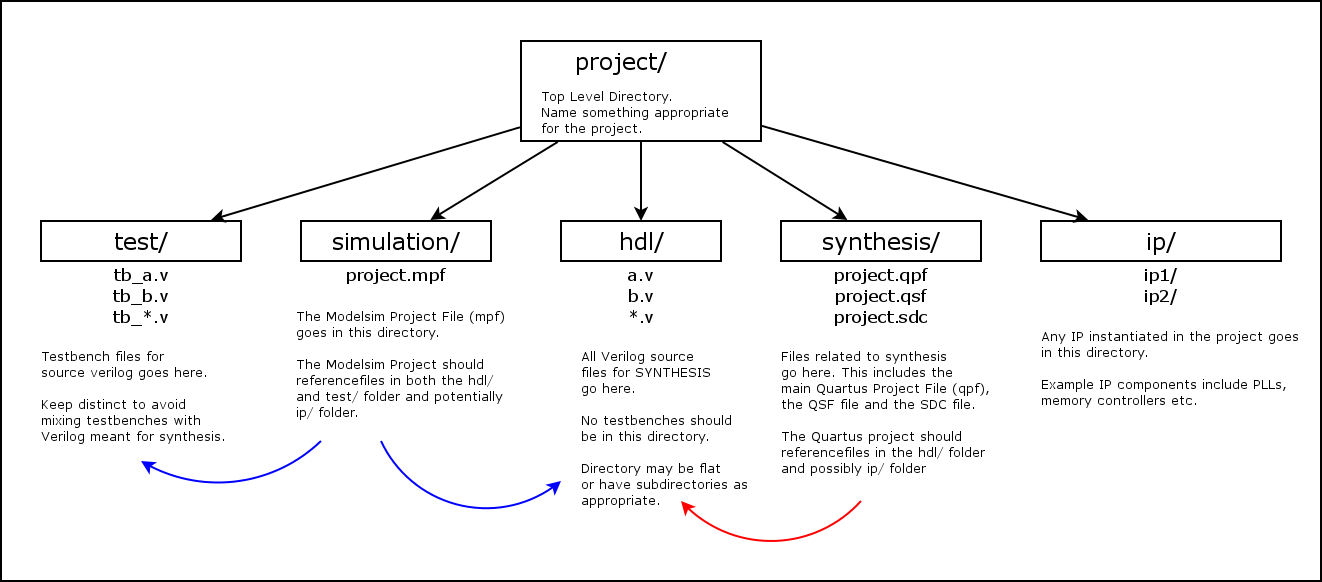Here are some notes of things that I learnt by failing:
- integer and natural is not recomended cuz you cannot set the number of bits.
- The variables in
this style:
- i_ Input signal
- o_ Output signal
- r_ Register signal (has registered logic)
- w_ Wire signal (has no registered logic)
- c_ Constant
- g_ Generic (VHDL only)
- t_ User-Defined Type
- p_ Process
- The architectures and entities should be called in minus. Otherwise they generate errors in simulation.
- Dont give a initial value to registers when you create them, it is ignored in the synthesis process. It should be initialized in the reset.
For some reason when you call an entity and you want to negate an input, you should do it as:
UUT_adc : entity work.adc_interface
port map(
i_clk => i_clk,
i_rst_l => "not"(i_rst),
o_adc_clk_12MHz => o_adc_clk_12MHz,
o_adc_nCs => o_adc_nCs,
i_adc_sdo => i_adc_sdo,
o_rx_adc => w_rx_adc,
o_rx_dv => w_rx_dv
);
Project structure

I prefer this way, that I saw on this IP:
- docs: A PDF with the documentation of the project. Explaining the testbench etc.
- project: Folder for the radiant project.
- simulation: Folder for saving the wave files, and the input/output of the tests.
- source: The source code, a subfolder called vhdl
- testbench: A subfolder called vhdl with the testbenches
Reset and initializing signals
-
DONT INITIALIZE A SIGNAL WITH A DEFAULT VALUE, The synthesis will ignore it. The simulation and the implementation will differ.
-
Use synchronous reset, guidelines of xilinx
-
Active-high resets enable better device utilization and improve performance.
-
it is recommended that you use the dedicated hardwired GSR. Check if the GSR is in auto.
library ieee;
use ieee.std_logic_1164.all;
use IEEE.NUMERIC_STD.ALL;
entity main is
port (
i_clock : in std_logic;
o_led : out std_logic;
i_rst : in std_logic
) ;
end entity main;
architecture arch of main is
constant CLOCK_FREQUENCY : integer := 12000000; -- input clock frequency (12 MHz)
signal counter : unsigned(31 downto 0); -- 32-bit counter to measure 1 second
signal r_led : std_logic;
begin
PROC_LIGHT : process( i_clock )
begin
if rising_edge(i_clock) then -- detect rising edge of input clock
if (i_rst='1') then
counter <= (others => '0');
r_led <= '0';
else
counter <= counter + 1; -- increment counter on each clock cycle
if counter = to_unsigned(CLOCK_FREQUENCY, counter'length) then -- check if counter reaches 1 second
r_led <= not r_led; -- toggle the LED on and off
counter <= (others => '0'); -- reset the counter to start again
end if;
end if;
end if;
end process ; -- PROC_LIGHT
o_led <= r_led;
end arch ; -- arch